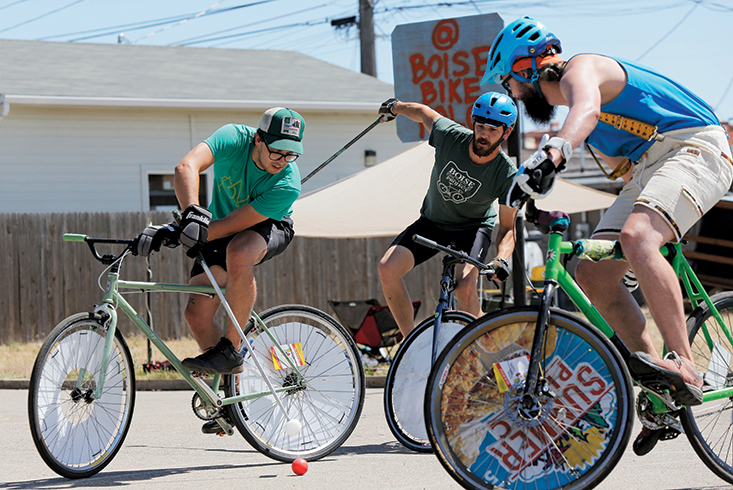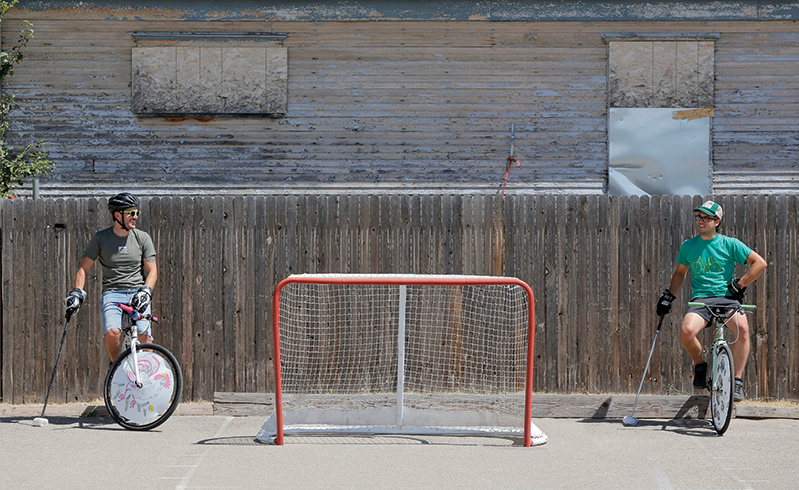It’s 93 degrees on a sun-scorched concrete lot on 18th and Idaho streets on the western edge of Downtown Boise—not hot enough to keep the Boise Bike Polo Club members from wielding their mallets, mounting their rides and soaking up their weekly Sunday match.
From a distance, the action looks like chaos as bicyclists stop, sprint and swing. But a closer look reveals strategy as players execute pinpoint turns to extricate themselves from corners or dexterously carry the ball through traffic like hockey players.
There’s more. Skillful, even graceful moments emerge from the havoc. Kody Schiermeier, known as Han Polo on Instagram, corrals a pass on his bike wheel before scooping the ball from the right side of his bike to the left before sending a backhand pass. Mac McManus, his lumberjack-looking brother in law, one-times the ball into the net.
As many as 15 players have turned out at once for the weekly matches. The group has enough regulars to field the three vs. three games, but Schiermeier, the club’s self-appointed cat herder, wants to bring more players into the fold. Robust polo scenes thrive in Bend, Salt Lake City, and the sport’s birthplace—Seattle—as well as in most big cities on the East Coast. He sticks invitation flyers in the spokes of bikes parked around town. He yells, “Play bike polo!” at bicyclists passing by the court.
“Once you play, you get the bug,” Shiermeier says. “It becomes a passion, especially if you like biking already.”
Several regulars played bike polo in Boise in the mid-2000s, but the scene had died until Schiermeier revived it in early 2018. He’d fallen in love with the game in Chattanooga, Tenn., and after moving here, he went to work gathering a squad. As a bike enthusiast and family member, McManus was an easy first mark. To find the rest, Schiermeier reached out to lurkers on a Facebook polo page set up more than a decade before. He also found new club members through Craigslist ads and by pestering folks he met riding bikes, especially those on single-speed rigs preferred by polo players.
“You have to spread the gospel,” he says. “After that, once you get those die-hards—the people who want to play on the weekend—it’s golden.”
Between games, McManus sips a beer and shrugs off the heat. He said he and Schiermeier make a point of playing through tough conditions because they are trying to build the scene.
“We come out when it’s just as compromisingly cold,” McManus says. “I look forward to it every week. We’re just starting it up, so we stick it out.”
Schiermeier now works on a farm in Bruneau, coming into Boise once a week with extra polo bikes for new recruits for matches. He’s thankful the lot owner gave them permission to use the property, which took about 20 hours to clean up and set up the sidewalls.
The Boise Bike Polo Club joined forces with several Bend guys and played in its first regional tournament recently in Seattle. He hopes for more tournament appearances. He’s also hoping to recruit more women, trans and femme players, as well all other minority groups. “Inclusivity is one of the big things in bike polo,” he says. “Diversity is good. We try to yell at everybody who rides by to play bike polo.”
He also dreams of raising bike polo in Boise to the visibility it enjoys in Salt Lake City, where the city paid for a court and where players gather for matches four times a week. In the meantime, he’ll keep evangelizing. “If you like bikes, you should try bike polo, at least once,” Schiermeier says. “I try to be religious about it, so people can come to polo church.”

Asphalt, bicycles, swinging mallets, balls zinging through the air … what could go wrong? Photo by Ken Erickson
WHAT IS BIKE POLO?
Bicycle polo was invented in the late 1800s in Europe as an alternative to traditional polo on horseback. Hard-court polo, the small-court style played in Boise, started in Seattle in the mid-2000s.
Players typically ride single-speed bikes that enable quick acceleration. Short wheelbases enable tighter turning. The plum-sized ball is made of plastic. The mallets are like longer, plastic versions of double-headed croquet mallets with one important difference: one mallet end is smaller, and this is the end that must be used to strike shots on goal. Players can otherwise “shuffle” the ball around the court, but the rule demands skill and “intentionality” of shots. Most players hold the mallet in their right hand and control the bike’s front brake with their left.
Court dimensions vary wildly because clubs often work with whatever public spaces are available. Short boards border the court, keeping the ball in play like a puck in a hockey rink. Players who touch their foot to the ground, or who crash, must “dab” by touching their mallet to center court before returning to the action. A number of rules exist limiting contact between players, bikes and mallets, but, to paraphrase Schiermeier, they simply add up to the adage:
Don’t be a jerk.

